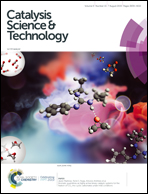Deactivation mechanism of hydrotalcite-derived Ni–AlOx catalysts during low-temperature CO2 methanation via Ni-hydroxide formation and the role of Fe in limiting this effect†
Abstract
When using undiluted H2 + CO2 feeds in stoichiometric ratios, it is necessary to use a reactor outlet temperature below about 320 °C in CO2 methanation in order to achieve equilibrium conditions which allow the specifications of natural gas to be met. Under these conditions, a deactivation mechanism different from that reported for higher temperature studies is observed in Ni/AlOx catalysts. The water which is formed in situ in the CO2 methanation reaction induces the formation of Ni-hydroxide, which at these low temperatures is not completely reduced to metallic nickel with a consequent decrease of the active phase (metallic Ni), easier sintering and formation of inactive side species. By using a catalyst with a nanosheet structure, prepared from hydrotalcite precursors containing low amounts of Fe, it is possible not only to obtain higher activity and selectivity, but also to enhance the reducibility of Ni-hydroxide during the catalytic reaction, obtaining stable catalysts under extended reaction tests. Under these reaction conditions, no deactivation by coke formation is observed.



 Please wait while we load your content...
Please wait while we load your content...